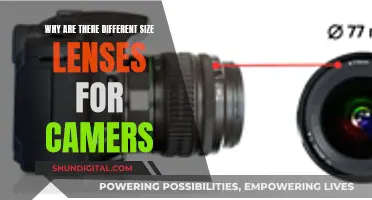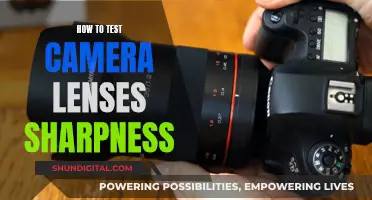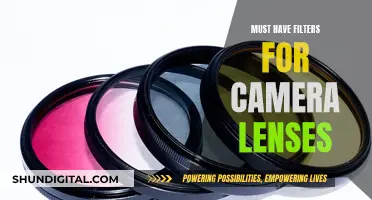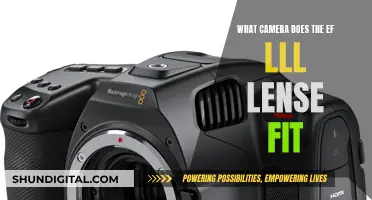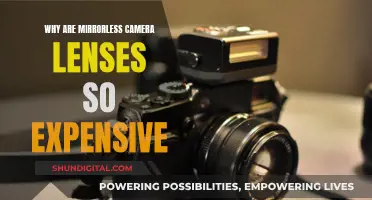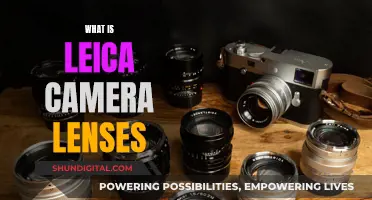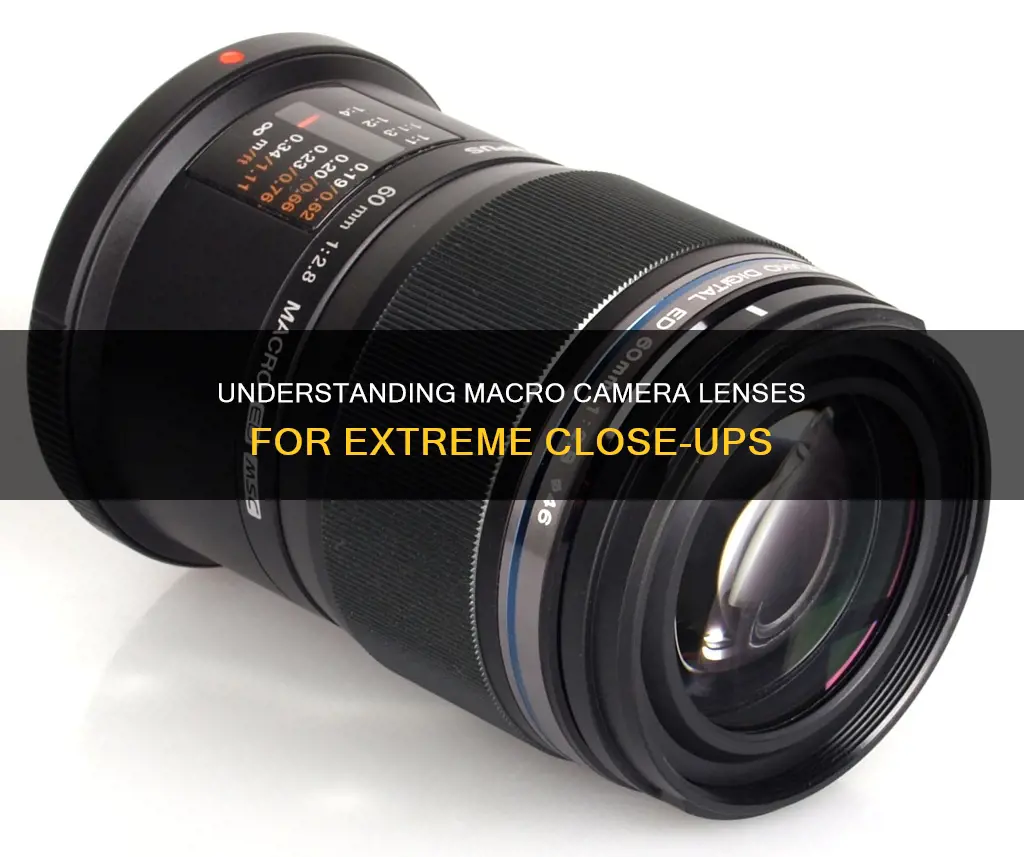
Close-up lenses, also known as close-up filters or supplementary filters, are a type of camera lens used for close-up or macro photography. They are called close-up lenses because they allow photographers to focus more closely on their subjects, resulting in greater magnification. These lenses are attached to the front of an existing camera lens, reducing the minimum focusing distance and enabling the camera to capture finer details. The strength of close-up lenses is typically measured in diopters, with higher numbers indicating greater magnification. While they are relatively inexpensive and easy to use, close-up lenses may suffer from reduced image quality, especially at wide apertures.
What You'll Learn

Close-up lenses are also called close-up filters or supplementary filters
Close-up lenses work by reducing the minimum focusing distance of your lens. This allows you to move your lens closer to your subject and achieve greater magnification. They are also easy to use. You simply screw them into the front of your lens and your camera will take care of the exposure and autofocus.
There are two types of close-up lenses: single-element and double-element. Single-element close-up lenses are the most common and the cheapest. However, they suffer from poor image quality due to lack of edge sharpness and chromatic aberrations. Double-element close-up lenses, on the other hand, contain two elements that correct these aberrations, resulting in excellent image quality. While they are more expensive than single-element lenses, the gain in image quality is worth the extra cost.
When choosing a close-up lens, it is important to consider the performance, which depends on the construction. Single-element lenses may be adequate for occasional use, but double-element lenses offer better image quality. The diameter of the close-up lens may also limit your choice of lenses, as you need to match the diameter of the lens to the telephoto lens you will be using.
Close-up lenses are a great option for photographers who want to get into close-up photography without spending a lot of money. They are easy to use, portable, and offer good image quality, especially the double-element lenses.
Leica Lenses: Panasonic Cameras' Secret Weapon?
You may want to see also

They are secondary lenses that enable macro photography
Close-up lenses, also referred to as close-up filters or supplementary filters, are secondary lenses that enable macro photography without the need for a specialised primary lens. They are similar to reading glasses in that they allow a primary lens to focus more closely, bringing the focus closer and giving the photographer more possibilities.
Close-up lenses are attached by screwing them into the filter thread at the front of a camera lens, rather than the camera's lens mount. They are called close-up filters because of this, although this is not strictly correct as they do not filter light. Close-up lenses are also referred to as supplementary lenses because they are used in addition to another lens.
Close-up lenses are ideal if you are looking for a relatively inexpensive and easy way to take close-up photos of flowers, insects, or any other interesting subjects. They are usually cheaper and more lightweight and portable than macro lenses. They also do not reduce the amount of light that reaches the camera's sensor, meaning you can retain a fast shutter speed to reduce the effects of camera shake and subject movement.
The strength of close-up lenses is measured in diopters, with the higher the number, the greater the magnification. Most close-up lenses come in strengths of +1, +2, +3, and +4 diopter, although they can go as high as +10 diopter. The more powerful lenses can get you very close to the subject, but this may come at the cost of a degradation in image quality.
There are three types of close-up lens: single-element, multi-element, and double-element. Single-element close-up lenses are the most common type and are ideal if you are on a budget or just want to try close-up photography without spending much money. However, the trade-off for the low price is image quality, as single-element lenses suffer from poor edge sharpness and chromatic aberrations. Multi-element close-up lenses, such as those made by Raynox, give greater magnification than single-element lenses. Double-element close-up lenses, also called dual-element or achromatic close-up lenses, offer the best image quality as the second element cancels out the aberrations and poor edge quality of the first.
Mounting Two Camera Lenses: A Step-by-Step Guide
You may want to see also

They are lightweight and portable
Close-up lenses are lightweight and portable, making them ideal for travel photography. They are easy to carry and can be transported in your kitbag without taking up much space. This makes them a convenient choice when you want to travel light and move around with ease while capturing stunning close-up shots.
Their compact size and portability do not compromise their functionality. Close-up lenses can be attached to the front of your existing camera lens, allowing you to focus closer than normal. They are designed to screw into the filter thread at the front of your camera lens, similar to how you would attach a filter. This means you don't need to attach them to your camera's lens mount, making them convenient to use without removing your camera lens.
The lightweight and portable nature of close-up lenses also offers benefits when it comes to lighting conditions. Unlike extension tubes, close-up lenses do not reduce the amount of light reaching the camera's sensor. This is advantageous, especially in low-light environments, as you won't need to adjust your ISO, aperture, or shutter speed to compensate for light loss.
Additionally, close-up lenses are a great option when you want to protect your camera from dust and dirt. Since you don't need to remove your camera lens to attach or detach a close-up lens, you can minimise the risk of dust and dirt entering your camera body, helping to keep your sensor clean.
Close-up lenses provide a lightweight and portable solution for photographers who want to explore the world of close-up photography without compromising on image quality or functionality. Their compact size and ease of use make them a convenient addition to your photography kit, allowing you to capture stunning macro shots wherever your travels take you.
Motorized Telescoping Lenses: Are They Reliable Camera Companions?
You may want to see also

They are cheaper than macro lenses
Close-up lenses are usually cheaper than macro lenses. They are ideal for photographers on a budget or those who want to try close-up photography without breaking the bank. Close-up lenses are also known as close-up filters or supplementary filters. They are called close-up filters because they screw into the filter thread at the front of a camera lens. However, they are not technically filters because they do not filter light.
Single-element close-up lenses are the most common and affordable type. They are often sold in camera stores and online marketplaces like Amazon and eBay, sometimes at rock-bottom prices. While they are ideal for those on a budget, the trade-off is image quality. Single-element lenses suffer from poor edge sharpness and chromatic aberrations.
Double-element close-up lenses, on the other hand, offer superior image quality. They contain two elements, with the second element correcting the aberrations of the first. This results in excellent image quality across the frame and minimal chromatic aberration. While more expensive than single-element lenses, they are still cheaper than buying a macro lens. Canon, for example, offers double-element close-up lenses that are more affordable than their macro lens counterparts.
Close-up lenses are a great option for photographers who want to get into close-up or macro photography without spending a fortune. They are easy to use, lightweight, and portable, making them a convenient addition to your photography kit.
Protecting Your Camera Lenses: Tips for Longevity
You may want to see also

They can be used with telephoto lenses
Close-up lenses, also known as close-up filters or supplementary filters, are an ideal accessory for photographers who want to travel light. They are relatively inexpensive and easy to use, and can be attached to the front of your camera lens to enable macro photography without requiring a specialised primary lens. They work by reducing the minimum focusing distance of your lens, allowing you to move your lens closer to your subject and achieve greater magnification.
Close-up lenses can be used with telephoto lenses to achieve even greater magnification. The longer the focal length of your lens, the more magnification you will gain by attaching a close-up filter. This makes them a good match for telephoto lenses, as the lens remains focused on the same point when you zoom in or out. Additionally, there is no loss of light when using close-up lenses, which is beneficial in low-light conditions.
When choosing a close-up lens, it is important to consider the construction and performance. Single-element close-up lenses are relatively inexpensive but may not provide the best image quality. They often suffer from chromatic aberrations and poor edge sharpness. On the other hand, double-element close-up lenses, also known as achromatic close-up lenses, offer improved performance by correcting aberrations and providing excellent image quality across the frame.
It is worth noting that the diameter of the close-up lens may limit the choice of lenses it can be used with. Additionally, image quality can degrade at wide apertures, even with good quality lenses. Therefore, it is recommended to use close-up lenses with a strength of around +2 diopter for better results.
Overall, close-up lenses are a great option for photographers who want to experiment with close-up or macro photography without breaking the bank. They are easy to carry, provide good magnification, and do not affect the amount of light reaching the camera's sensor.
The Ultimate Lens Kit for Your Mirrorless Camera
You may want to see also
Frequently asked questions
Camera lenses for close-ups are called close-up lenses, or close-up filters/supplementary filters. They are also sometimes referred to as diopters, macro filters, or supplementary lenses.
Close-up lenses are secondary lenses that enable macro photography without requiring a specialised primary lens. They work like reading glasses, allowing a primary lens to focus more closely. They are attached by screwing them into the filter thread of the primary lens.
Examples of close-up lenses include the Canon 500D close-up lens, the Raynox triple-element close-up lens, and the Nikon 3T, 4T, 5T, and 6T double-element lenses.


